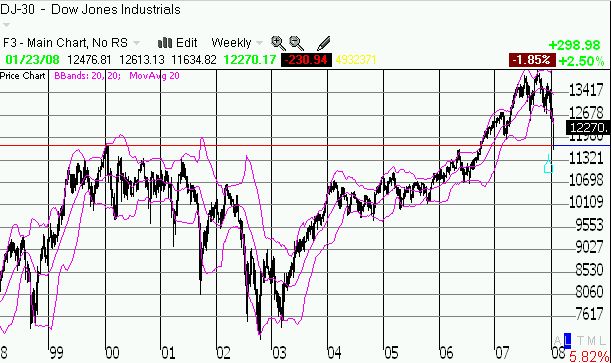At the end of 2007, I effectively declared 2008 "the year of Taleb." In early January, I did a book review for Michael Covel on his latest book "The Complete Turtle Trader."
Nassim Nicholas Taleb tells us that we humans constantly underestimate the likelihood of rare events. He also reminds us that we cannot conclude an event is impossible just because we have not yet observed it. Taleb calls this the "black swan" problem. The "Turtle Traders" were a group of traders hired by legendary trader Richard Dennis to prove that anyone could be taught the discipline of trading, particularly trend-following. One of Dennis's key trend-following premises is that trends tend to persist longer than anyone expects. (Keep reading below...)
How are these concepts particularly relevant now? Well, back in October, many of us were marveling at the market's resilience given new multi-year highs in the S&P 500 and NASDAQ despite sub-prime tremors and whispers of recession. Folks were concluding that high-growth, big-cap tech stocks were the great places to "hide" from credit problems (you can probably also toss in China-related stocks, solar stocks, and agricultural stocks into that mix). Only the hardcore (perma)bears were left insisting that deep trouble was still around the corner. And when we got the unusual start to the year, we got our black swan event that all but confirmed the developing downtrend. And as the selling unfolded, you did well NOT to think you could pinpont the end to the selling and just keep following everything down until further notice. Throughout January, we have heard things like "the worst start to a year ever" and "the worst weekly performance since World War II." Those are surely the squawks of black swans, and trend followers were soaking it all up and in. And I have still not forgotten that the tech bubble that burst in 2000 was a bubble of historic and epic proportions. Does it not make sense that the ultimate resolution of that event will also be something of a similar, if not a greater, magnitude? I think 2008 will provide ample opportunity to witness more black swans and turtles in action.
Trader Mike does a good job at showing why we might be at a transition point in the selling. But note well the tough resistance that lies directly overhead, distinctly defining the current downtrend. The Federal Reserve did what it could to arrest the persistent and panicked selling. It is interesting to note that our central bank was alone across the planet in thinking that the global market sell-off needed an immediate, monster, surprise rate cut, even with a meeting one more week away. The Fed panicked along with the market again and, given the initial tepid response to the surprise move, we must assume that the market is demanding even more rate cut candy at next week's meeting. I feel for Bernanke at this point. He is getting blamed for the huge credit mess that Greenspan delivered to us, and Bernanke is left with few tools to solve the problem. I strongly suspect that the market is going to have to figure this one out on its own somehow. The Fed probably has no more asset bubbles in which to hide (temporarily) our economic problems.
I end with a quick note on the Dow Industrials. I rarely use this price-weighted index as an indicator for anything anymore, but I found it interesting from a technical perspective that the selling in the Dow stopped right at the old all-time highs from 1999/2000. This means we just barely preserved the big, celebrated break-out back in 2006. This also means that this break-out is in big danger of being proven FALSE. Hard to imagine 8 years running and still no real progress, right?
Be careful out there!
